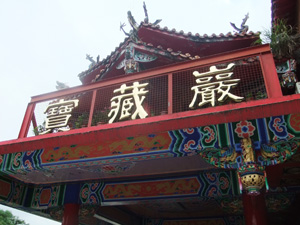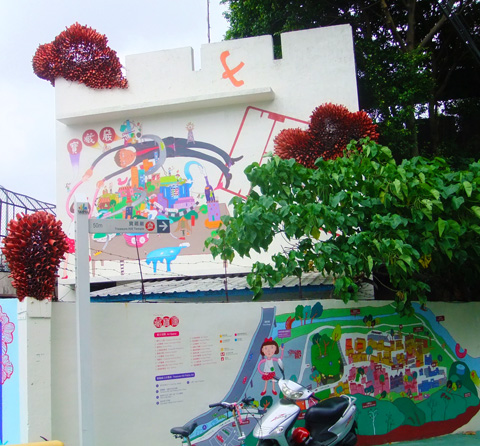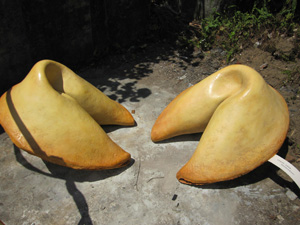Living in a world of art is not a dream at Treasure Hill
By Cho Yin-cheng Visitors following direction signs up the hill first encounter a giant wall painting right where the road ends. This lively portrait of daily urban scenes is an artistic creation inviting visitors to further explore the community. Occupying an area less than four hectares in the bustling Gongguan district, Treasure Hill community tops out at a height of 80 meters. Taking its name from the Buddhist temple of the same name which was built 300 years ago in the community, Treasure Hill still did not constitute a real community until soldiers withdrawing with the Kuomintang government to Taiwan in 1949 built their homes along the hillside. “The number of households reached over 100 during the 1960s and 70s. Residents consisted of veterans, college students and immigrants,” said Hebe Lin, a crew member at THAV, on October 25. Venturing further into the community, a board reading ‘No Entry’ in front of residents’ houses reminds visitors that they’re visiting a place which is not a solely an artists’ village. So far, 22 out of 100 or so former households have stayed and continued their lives here. To better take care of elderly residents, the Tsuei Ma Ma Foundation for Housing and Community Service has been retained to set up contacts here. “Every afternoon, the staff pays a visit to seniors to provide real-time help,” said Lin. Mr. Pai, 85, a lifelong resident of Treasure Hill, still remembers the time when there were only six households in the entire community. He maintains a positive attitude toward his new artist neighbors, hoping they might breathe new air into the community. Still farther into the village stands Treasure Hill Pagoda, looming beside the pathway to create an interesting scene. “Many people say that Treasure Hill is a place where deities, human beings and spirits live together,” said Lin with a smile. Operating under the ideal of creating a new village that will provide space for both living and art, most of THAV’s operations will be linked to three major projects - ‘Hometown preservation and revitalization’, the ‘Artist-in-Residence program’, and a ‘Youth Hostel’. THAV, with its unique location, stands out among the three art villages currently active in Taipei, namely, THAV, Taipei Artist Village and Grass Mountain Artist Village, notes Su Yao-hua, director of the Taipei Culture Foundation, which has assumed responsibility for this old community since earlier this year. Lin shares the same idea and adds that “The three artist villages are all different in their styles and ways of artistic expression as well.” Outsiders visiting THAV will probably pay attention to the creative processes used by most artists, rather than appreciating the finished products, adds Su. The first five artists selected to base their creativity here for a continued three to six months have said they will seek to represent and bond with locals in developing their works. “The street furniture in different styles is designed to fit in with the environment,” said Lin, pointing to a submarine-shaped chair with periscope oriented toward the river which rushes by the village. Tweaking children’s curiosity is just one part of the creative team’s idea. They have also prepared something for grown-ups: two giant fortune cookie-styled chairs installed in a relatively small space looking down upon the flowing water. “Small spaces help to create an intimate feeling for couples. They can enjoy the great view and have time to themselves,” Lin said, explaining the concept behind the artist’s works. Down the riverbank, artist Pan Yi-ro has set up a landscape artwork called ‘See or Be Seen’ which projects light onto the settlement right next to the Historical Facades, which record changing housing styles. Anyone who steps into the light will find his/her shadow projected onto the facades where the artist wishes to create a conversation between humans and history. Farther beyond this still installation, the five artists now residing in the village are also preparing to ‘interact’ with inhabitants as well as the city. Interdisciplinary artist Ye Yu-jun plans to continue the concept in ‘Project Series—Moving Performance for the City (Taipei)’ by inviting residents to perform gymnastics, while Wang Li-hsin, with a focus on visual art, begins her ‘drying laundry’ project, hoping traces on clothing will stimulate memories for the owners. Artists share the ideal that their projects will make Treasure Hill more livable, and the idea is realized not only from a biological perspective, but also in really integrating themselves into the community. As part of being recognized as members of the community, artists become friends with the village children, said Lin. Having officially opened on October 2 following a four-year long renovation and rebuilding project, the reformed Treasure Hill invites the public to discover treasures that are embedded in history. Guides are available Tuesday to Friday. Please call 02-23645313 ext. 130 to make a reservation or visit www.artistvillage.org
Staff Reporter Creating an art village is nothing new, but creating one that incorporates living and art creation might be a new tack. Taipei’s Treasure Hill Art Village (THAV), transformed from an old community into a thriving group of artists, is the fruit yielded in one such attempt.
Creating an art village is nothing new, but creating one that incorporates living and art creation might be a new tack. Taipei’s Treasure Hill Art Village (THAV), transformed from an old community into a thriving group of artists, is the fruit yielded in one such attempt.
The remaining empty houses will be used to build hostels, bookstores and studios. A total of 17 studios, 2 rehearsal studios and 3 exhibition spaces are available in the artist-in-residency.
Art—playable and livable Visitors wandering the tiny alleys and climbing up and down the stairs in THAV may unexpectedly encounter some surprises prepared by artists. For the time being, there are six chairs in bright yellow with six poems scattered around the hill village.
Visitors wandering the tiny alleys and climbing up and down the stairs in THAV may unexpectedly encounter some surprises prepared by artists. For the time being, there are six chairs in bright yellow with six poems scattered around the hill village. Taking a walk in the tiny and densely-populated village, the air is infused with the refreshing smell of greenery. Many different plants can be found around the community, as ecology is one of the top concerns among the artists currently residing in the village, indicated Lin.
Taking a walk in the tiny and densely-populated village, the air is infused with the refreshing smell of greenery. Many different plants can be found around the community, as ecology is one of the top concerns among the artists currently residing in the village, indicated Lin.

![Taiwan.gov.tw [ open a new window]](/images/egov.png)
